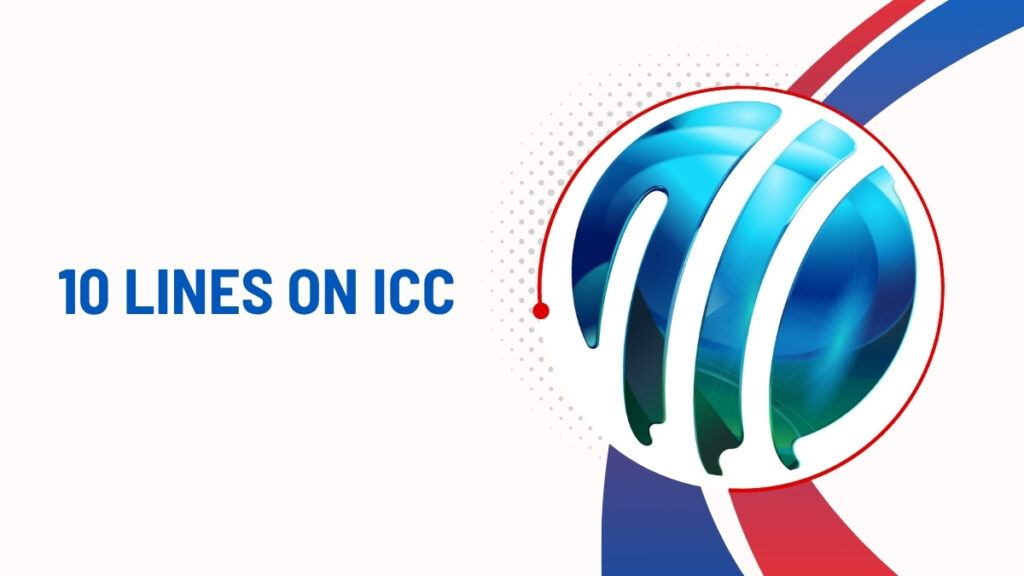Hey, have you ever thought about who actually runs cricket around the world? Like, who makes the rules, sets up the World Cup, or decides team rankings? That’s all done by the ICC, which stands for International Cricket Council.
It doesn’t play the game, but it makes sure everything runs smooth and fair—kind of like the manager behind the scenes. The ICC plans the big tournaments, helps new countries get into cricket, and keeps the rules the same everywhere.
If you just want a quick idea of what it does, these 10 lines on ICC will give you the full picture in no time. But honestly, once you know how much it handles, you start to see cricket in a whole new way. The game wouldn’t be the same without it.
10 Lines on ICC PDF
10 Lines on ICC
From thrilling World Cups to setting the rules of the game, the ICC is the heartbeat of international cricket. Let’s dive into 10 quick lines that show why the ICC matters to every cricket fan around the world.
1. Beginnings: 1909 and the Colonial Roots
Let’s start at the beginning. Imagine 1909—no smartphones, no instant messaging; cricket was simpler, cooler in a nostalgic way. The ICC was born under the regal name Imperial Cricket Conference, founded by just three nations: England, Australia, and South Africa. Those were the cricket giants of that era.
In that setup, cricket was an exclusive club. The ICC at that time wasn’t about growth—it was about harmony. Making sure Test matches between these countries used the same rules. Back then, it wasn’t even thinking about world impact—it was guardianship, preserving tradition among those few.
But it wouldn’t stay that way forever. The game began crossing oceans and national boundaries. Newer cricket nations crept in, pushing the ICC to expand its vision.
2. Name Shifts, Vision Shifts (1965, 1989)
Over the decades, cricket changed and the ICC had to transform with it.
In 1965, the Imperial Cricket Conference dropped “Imperial” and became the International Cricket Conference. It sounds minor, but it marked the start of opening doors beyond the Commonwealth. It was a signal: cricket was expanding.
Then in 1989, it streamlined once more—becoming the International Cricket Council. That change wasn’t just cosmetic. It aligned the council with global sports governance models—like FIFA and the ICC for football.
During this period, cricket’s growth momentum picked up. Bangladesh was rising, and the West Indies and Pakistan were asserting influence on the global stage. All the while, the ICC began establishing structures for marketing, governance, policy, and accountability. Because cricket would no longer just rely on old-school colonial dynamics.
3. Membership Hierarchy: Who’s in, Who’s Out?
Today, the ICC proudly supports 108 member nations. That’s a lot compared to its three founding members. But not everyone in that list holds the same power.
There are two main tiers now:
Full Members
The 12 nations authorized to play Test cricket (India, Pakistan, England, Australia, New Zealand, Bangladesh, South Africa, West Indies, Sri Lanka, Zimbabwe, Afghanistan, Ireland). These are the big dogs with voting rights and a voice in major decisions.
Associate Members
A next level below. Telling stories of them rising through the ranks is where the ICC’s development work shows. Associates play ODIs and T20s, can earn World Cup qualification, and sometimes threaten to break into the Full Member circle.
Previously, there was an Affiliate Member tier, but that’s been phased out since 2017. So now there are Associates and Full Members. It’s neat—and yes, aspirational for countries like Scotland, Nepal, or the USA.
The real-world story is how Afghanistan and Ireland used the Associate route to reach Full Member status. That’s a big deal. It shows growth isn’t just possible—it’s real.
4. Leadership: Who Makes the Calls?
So who decides if a day’s play gets called off for rain, or how much each team earns from sponsorships?
The ICC structure is sophisticated. At the top are the Chairperson, Deputy Chair, and a Chief Executive Officer (CEO). These people set strategy and guide day-to-day leadership.
But decisions are driven through committees, each responsible for a segment of the game:
- The ICC Board – The ultimate authority on tournaments, regulations, finances.
- Chief Executives’ Committee – Heads from member boards pooling insights and strategy.
- Finance & Commercial Affairs Committee – Money speaks loudly in sport; this group handles how it flows.
- Cricket Committees (Men’s & Women’s) – Decide on match conditions, game rules, format structure.
- Anti‑Corruption Oversight Group – Ensures integrity, handles controversial issues.
Yes, Full Members wield more influence at decision tables, but that system allows a mix of vision and cooperation. It’s not always pretty—but it usually works for the complexity of running a global sport.
5. Signature Events: Where the World Watches
The ICC is known for signature tournaments—the events that stop the world:
Cricket World Cup (ODI)
Held every four years. This tournament has grown into a monster: over 1.6 billion viewers watched the 2019 Men’s edition. The finals become something of global consciousness. Iconic moments—Don Bradman, Kapil Dev, Ml Adams, Mitchell Johnson—they become immortal.
T20 World Cup
Introduces firecracker cricket. Quick, intense, and perfect for new fans. Since its introduction in 2007, it’s attracted young audiences and cricket-curious markets. Women’s T20 World Cups are now big attractions too.
World Test Championship
A recent addition giving structure to Test cricket. Instead of stand-alone series, it now has points, standings, and a final. It ties Test tours together so each series matters.
Champions Trophy
A compact elite ODI-based tournament featuring only top-ranked teams. Though held irregularly, it’s beloved for its competitiveness and edge-of-seat cricket.
Women’s World Cup
Gaining ground fast—world-record crowds, huge hype, and growing media attention. Women’s cricket is no longer an afterthought. Audiences care deeply.
The ICC ensures these events are fair, transparent, and professionally handled—from pitch preparation to DRS, and from ticket sales to the TV presentation.
6. Rankings, Regulations, and Playing Conditions
Rankings—team and player—power the narrative. The ICC publishes:
- Team Rankings: for Tests, ODIs, and T20Is. These affect tournament placement, World Cup spots.
- Individual Rankings: for batters, bowlers, and all-rounders. Earn points, gain reputation.
Rankings depend on recent performance, strength of opposition, match significance. They’re updated continuously.
The ICC also sets Playing Conditions. They define every decade of the game—from ball color to pitch dimensions, DRS protocols, weather-related adjustments—and not just in Tests, but across all formats. The ICC ensures consistency: no country can exploit bizarre local conditions unfairly.
7. Integrity Game: Anti‑Corruption Enforcement
Cricket’s beauty is threatened when fairness is broken. That’s why the Anti-Corruption Unit (ACU) exists. Their mission? Monitor betting patterns, investigate suspicious activity, educate everyone—from players to ground staff.
High-profile scandals marked the early 2000s. Remember the 2010 Pakistan spot-fixing scandal at Lord’s? It shook the sport. The ICC responded strongly, with bans, legal action, and stricter rules.
Today, players are compelled to report offers. Tournaments have dedicated anti-corruption monitors. Phones, internet use, and hospitality are all monitored.
It’s not perfect, but the message is clear: cricket doesn’t mess around with integrity.
8. Growing Cricket: Development Missions
The ICC isn’t just about elite competition. It works hard to grow the game—especially in Associate nations.
This isn’t a small effort:
- Funding runs into the hundreds of millions. That supports pitches, training centers, youth programs.
- Governing bodies in places like Nepal, Namibia, Italy, and the USA received funding that helped build academies and start domestic leagues.
- Coaching certifications are provided. Women’s leagues have been launched. Young players get soccer-ball or tape-covered machinery to practice with.
It’s slow work, but it’s essential. Bringing up new teams means wresting matches from well-established nations—and globalizing cricket truly.
9. The Business: Broadcasting, Rights, Sponsorships
Cricket’s survival—and growth—depends on visibility and money. The ICC handles global broadcast rights trades, sponsorship deals, and merchandising.
The 2024–2027 broadcast cycle generated multiple billions. India remains the largest single market, accounting for much of that. The money is distributed—Full Members take the lion’s share, but put quite a bit back into Associates.
ICC-powered digital content is huge: highlights, supercuts, social feed, player interviews—most watched by fans under 30, or those who skip traditional formats altogether.
That revenue funds everything from umpire training to youth programs, from women’s cricket to developing nations’ infrastructure.
10. The Future: Formats, Technology & Fan Engagement
Cricket never stops innovating. Let’s look into what’s trending:
New formats
- T10 cricket — ten overs; ultra-fast pace
- The Hundred — 100-ball innings; low complexity, quick results
These formats don’t replace traditional ones. But they open the door to younger viewers and quicker entertainment.
Tech and digital fan engagement
- DRS: Umpires get a second, third chance—makes officiating more accurate.
- Ball-tracking, UltraEdge: keeps fans glued to replays.
- Live analytics, social stories, fantasy game tie-ins: new ways to watch.
- New brands, new viewers—the fanbase grows.
For the ICC, the goal is to modernize the sport while preserving the essence—Test cricket for purists, T20 for thrill-seekers, emerging formats for new fans.
Conclusion: Tradition. Innovation. Global Reach.
When you step back, what does the ICC stand for today?
- Organizing global cricket—from World Cups to bilateral series
- Managing fairness—through rules, conditions, and anti-corruption
- Supporting growth—by investing in developing cricket nations
- Structuring the game—Rankings, formats, and commercial
- Embracing changes—through formats and technology
Maybe it’s not perfect. It faces criticism—corporate pressure, governance, booking decisions. Yet it keeps moving forward, adapting, and pushing the sport globally.
That’s what makes cricket fascinating. It’s an old game, wrapped in tradition—yet the ICC is finding new ways to drive it into the future.
Alberto Robino is a passionate content creator who specializes in sharing concise, insightful, and engaging 10-line facts on a variety of topics. With a love for simplifying complex ideas, he enjoys providing quick, digestible information to help people learn fast.



